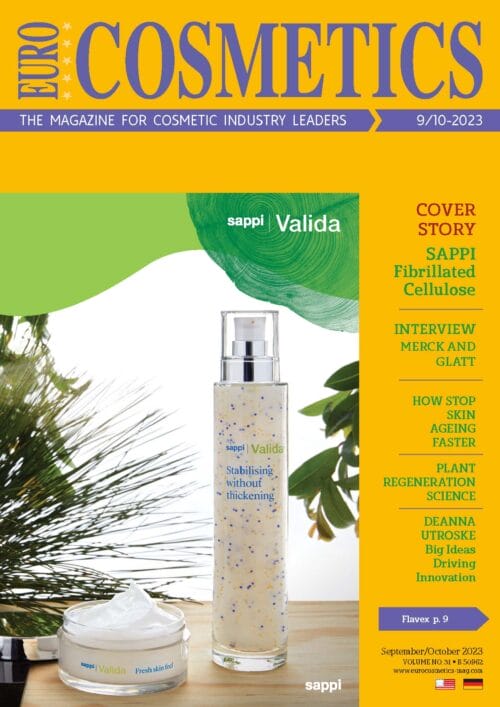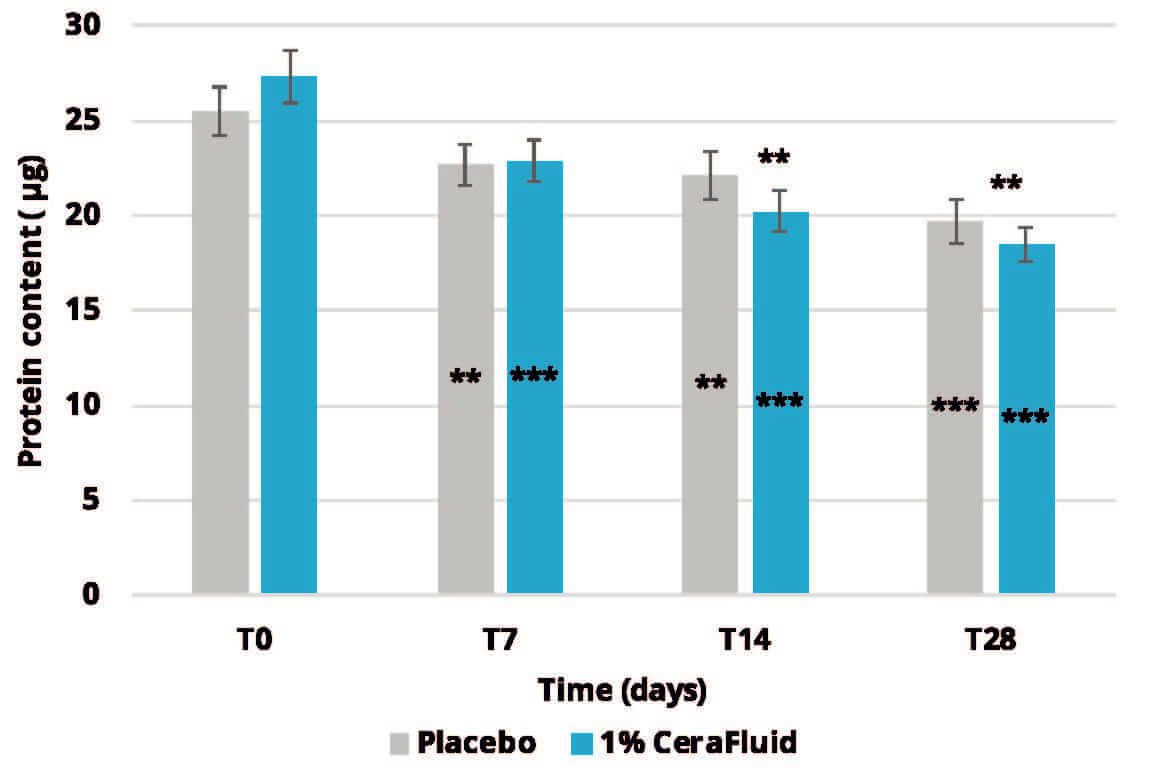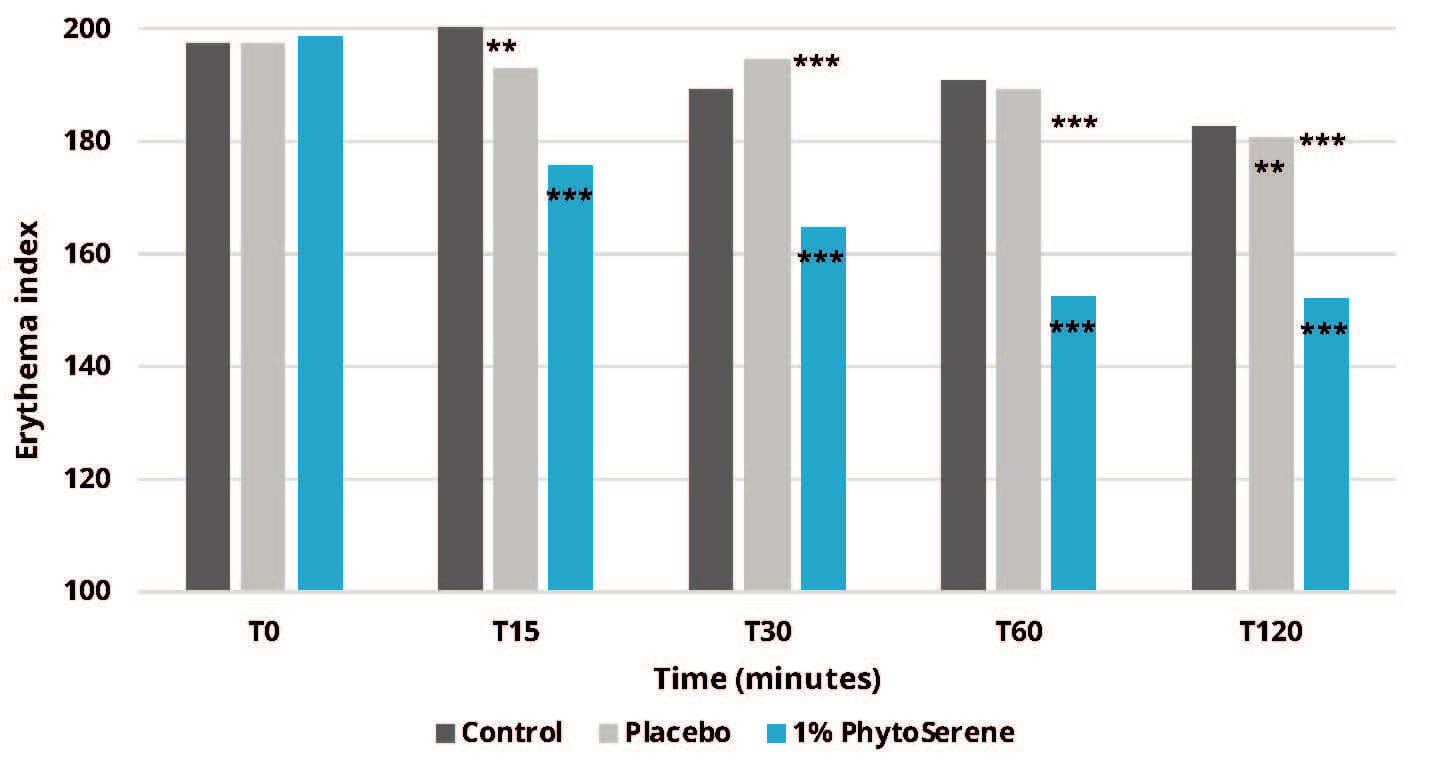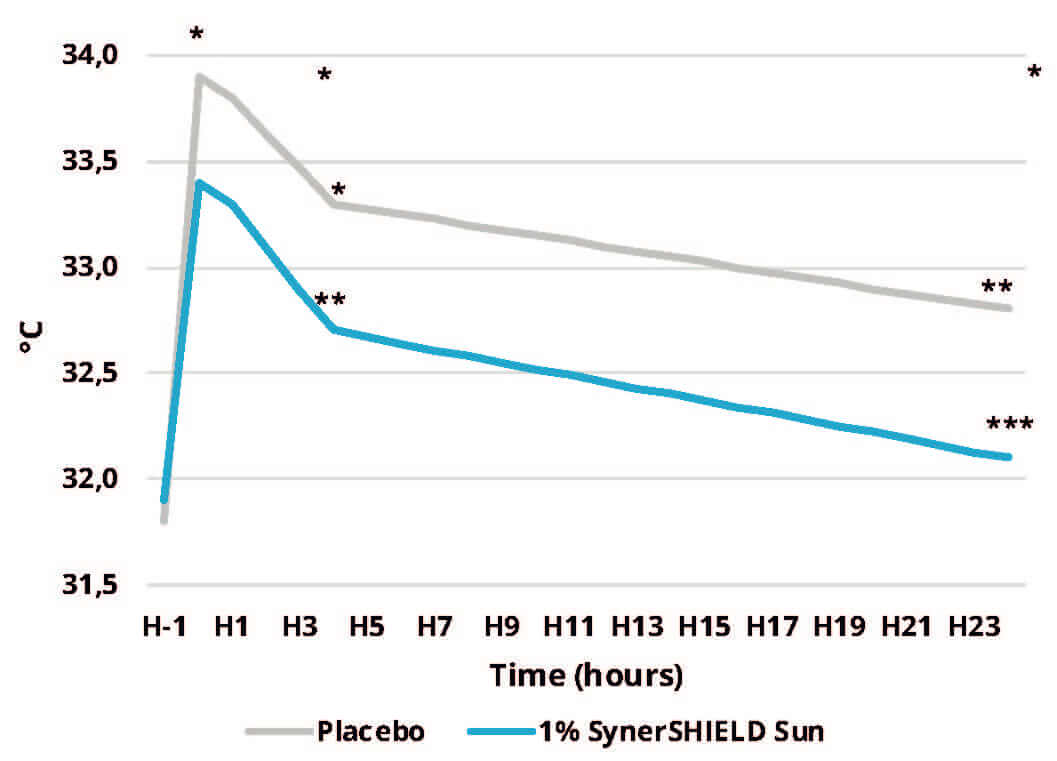
Introduction
In recent years, Earth has been experiencing the repercussions of pollution, exemplified by the thinning of the ozone hole. This phenomenon gives rise to numerous inconveniences, foremost among them being the penetration of UV rays through the atmosphere. These UV rays constitute a component of the exposome and are responsible for various skin disorders. Among the types
of UV radiation, sunlight stands as the most prevalent source, giving rise to three primary variants: UVA, UVB, and UVC rays. The majority of skin-penetrating UV rays consist predominantly of UVA, accompanied by a minor quantity of UVB. UVB rays, characterised by their short wavelengths, impact the outer skin layer (the epidermis), engendering skin redness and desquamation. UVA rays, with longer wavelengths, can permeate the intermediate skin layer (the dermis), contributing to skin inflammation, skin aging and itching. 1
The aim of this article is to present three cosmetic active ingredients able to mitigate these issues. In alignment with ROELMI HPC’s methodology, focused on the development of ethical
and nature-based products, these suggested remedies conform to the tenets of sustainability and proven efficacy.
Innovation for Sun Derived Skin Discomforts
Having conducted an extensive study of skin physiology and its requisites, the company has developed three distinct active ingredients designed to effectively counteract the specific issues arising from sun exposure in a unique and synchronous manner. CeraFluid® represents a readily accessible ceramide, crafted to reinstate the compromised skin barrier ensuing from sunlightinduced damage. Phytoserene is engineered to alleviate inflammation and after sunburn, while SynerSHIELD™ Sun functions like to a protective shield, safeguarding the skin from solar aggressions by diminishing skin redness and mitigating elevated skin temperature during sun exposure.
The Skin Rebuilder
The skin barrier constitutes the outermost layer of the skin, and its preservation is essential for the maintenance of skin health. This vital function is attributed to the intercellular lipids present
within the outer layer, known as the stratum corneum. The composition of these lipids primarily includes ceramides, cholesterol, and free fatty acids. Alterations in the lipid composition of the
stratum corneum and the subsequent impairment of barrier function are observed in various skin conditions, including instances such as atopic dermatitis. 2
Particularly noteworthy is the fact that after exposure to sunlight, the skin barrier undergoes significant disruption, resulting in the loss of these essential components. In response,
ROELMI HPC has undertaken research to develop an active ingredient capable of restoring the skin barrier in terms of ceramides. This active ingredient, known as CeraFluid®, consists of Ceramide NP in conjunction with a matrix of upcycled olive oil glycerides, as a delivery system. Its INCI name is Triolein, Glyceryl Dioleate, Ceramide NP. Ceramide NP, being the fundamental ceramide responsible for forming the skin’s barrier, is widely employed in the cosmetic industry to fulfil this requirement. This delivery mechanism represents a ground-breaking development, facilitating improved dermo-mimetic activity throughout the layers of the skin by replenishing the natural ceramides lost during instances of stress exposure. Consequently, the skin attains heightened hydration levels while experiencing a reduction in trans-epidermal water loss (TEWL), a characteristic phenomenon of dry and stressed skin.
The efficacy of CeraFluid® in reinstating skin cohesion following exposure to stressors was rigorously examined. This evaluation involved the measurement of skin surface properties on 20 women utilizing the tape stripping technique with the Corneofix® instrument (Courage+Khazaka, electronic GmbH). This procedure enabled the determination of skin protein content within the stratum corneum. The outcome of this 28-days cream treatment revealed a demonstrable improvement in skin cohesion attributed to the activity of Ceramide NP. (Figure 1)

CeraFluid® distinguishes itself as an exceptional product, offering distinctiveness not solely due to its efficacy in skin barrier reconstruction, but also due to the added value it imparts through its application methodology within formulations. This peculiarity emerges from its harmonious integration with olive oil glycerides, facilitating the utilization of the active ingredient at a notably lower temperature of 40 °C – contrasting markedly with conventional ceramides that necessitate much higher temperatures ranging from 80-90 °C. This differential characteristic substantiates the endorsement of CeraFluid® as a user-friendly ceramide, underlining its convenient usability, plus the reduction in energy consumption during the manufacturing process of cosmetic formulations.
The Soother to Relieve Stressed Skin
Damage to the skin barrier not only affects on the ceramides, but also the cholesterol composition of the skin wall. The skin barrier impairment not only impacts ceramides but also influences the composition of cholesterol within the skin’s structure. The epidermal lipids within keratinocytes play an essential role in the skin’s barrier function. These lipids establish a barrier against the passage of water and electrolytes, thus averting transepidermal water loss (TEWL), while also providing a barrier against the invasion of microorganisms. Perturbation of the skin’s barrier function results in a swift and pronounced elevation in the demand for epidermal cholesterol and fatty acids.
In response to this exigency, the research and development laboratory has introduced an active ingredient designed as a cholesterol substitute: PhytoSerene. Comprising phytosterols, these plant-derived sterols, sourced from tall oil of pine bark, have the capacity to rejuvenate the skin’s barrier. Structurally akin to cholesterol, phytosterols possess the ability to supplant it. Leveraging their lipid origin, they not only enhance barrier function but also facilitate cell renewal, offer protection against free radicals and oxidative stress (as illustrated in Figure 2).

The stimulating impact of phytosterols on skin fibroblasts and keratinocytes yields manifold benefits. It fosters the production of hyaluronic acid, augments barrier function, and elevates the synthesis of essential proteins such as loricrin, filaggrin, and involucrin. This, in turn, leads to enhanced moisture retention, generation of natural moisturizing factors (NMFs), and improved skin elasticity, smoothness, and youthful appearance.
Phytosterols exhibit vitamin-like properties that influence the immune system’s functionality. Furthermore, they diminish the release of specific pro-inflammatory cytokines, inhibit STAT1, enhance the anti-inflammatory effects of IL10, and hamper the translocation of NF-kB to the cell nucleus. In response to the imperative requirement of restoring skin barrier integrity following intense stressors such as sun exposure, it was conducted an evaluation of PhytoSerene’s impact on erythema. The experimental protocol involved inducing an irritant response via the application of an epicutaneous patch containing Sodium Lauryl Sulfate (SLS), a potent irritant surfactant. Subsequently, an emulsion containing the active ingredient was applied. This study enlisted the participation of 20 volunteers ranging in age from 25 to 65 years, employing the Mexameter® method. After 120 minutes, treatment with the phytosterols-based cream led to a notable reduction in the erythema index.
Based on these results, Phytoserene demonstrates potential as an effective countermeasure against UV radiation-induced erythema and skin inflammation, with the capacity to restore the proper composition of the cutaneous barrier.

The Taking Care about Sunkissed Skin
UVA rays have the ability to penetrate the dermal layer of the skin, resulting in inflammation and dryness. Utilizing effective skin protection measures is essential, ensuring they not only alleviate the harmful consequences of UV radiation but also refrain from posing potential risks to the skin.
The company has identified an active ingredient, known as SynerSHIELD™ Sun, which effectively combats the adverse effects of sun exposure. This innovative product is derived from the synergistic combination of β-glucan, sourced from the cell wall of oyster mushrooms, and the flower extract of Perennial ryegrass. The mechanism of action is primarily attributed to β-glucan’s capacity to inhibit the inflammatory pathway. Scientific studies have demonstrated that β-glucan, a clinically significant nonspecific immunomodulator, can significantly attenuate the expression of pro-inflammatory cytokines and systemic inflammation.4
β-glucans derived from fungi exhibit a broad spectrum of biological activities, including anti-tumor, immune-modulating and anti-inflammatory properties. The anti-inflammatory effect is mediated through the regulation of various inflammatory cytokines, such as nitric oxide (NO), interleukins (ILs), tumor necrosis factor alpha (TNF)-α, interferon gamma (INF)-γ, as well as non-cytokine mediator and prostaglandin E2 (PGE2). Cytokines, small proteins or glycoproteins, play a pivotal role in transmitting information between cells. These molecules are secreted and responded to by most cells in the body, influencing a diverse array of cellular functions. Cytokines produced by cutaneous cells during inflammatory processes encompass a wide array of regulatory proteins within the immunologic system.5
Perennial ryegrass, the other key component in SynerSHIELD™ Sun, possesses regenerative properties that facilitate the restoration of the skin’s barrier function. These unique attributes make the product exceptionally suitable for post-sun exposure skincare applications.
A study was conducted to assess the efficacy in regulating skin temperature during sun exposure, maintaining a cooler temperature profile over time. This investigation involved 20 female volunteers who were subjected to UV exposure to induce skin discomfort. The product’s performance was evaluated in comparison to a placebo and a negative control at baseline, prior to exposure, and subsequently at 1, 4, and 24-hours intervals. Skin temperature measurements were recorded using an electronic infrared thermometer – the Thermofocus model 01500A3, manufactured by Tecnimed srl. (Figure 4)
By halting skin inflammation and rejuvenating the skin barrier, the ingredient results in a reduction in elevated skin temperature caused by ultraviolet rays, providing relief to the skin.

Conclusions
Through the introduction of these three products, the company presents a comprehensive summertime daily skincare routine designed to address all aspects of skin care comprehensively. The key concept revolves around the flexibility of employing a dedicated product for specific purposes or utilizing all the products within a single multi-functional formula. These ingredients allow a holistic skin rejuvenation following exposure to the sun.
Bibliography
- Ultraviolet Radiation, FDA, August 2020
- Barrier Capability of Skin Lipid Models: Effect of Ceramides and Free Fatty Acid Composition; Lorretta.E. Uche, Gerrit.S. Gooris, Joke.A. Bouwstra*, and Charlotte.M. Beddoes, November 2019
- Epidermal surface lipids, Apostolos Pappas, March 2009
- Beta-glucan attenuates inflammatory cytokine release and prevents acute lung injury in an experimental model of sepsis; Bedirli Abdulkadir, Kerem Mustafa, Pasaoglu Hatice, Akyurek, Nalan, Tezcane Tugan, Elbeg Sehri, Memis Leyla, Sakrak Omer, April 2007
- An insight into anti-inflammatory effects of fungal beta-glucans; Bin Du, Chengyuan Lin, Bian, Zhaoxiang, Baojun Xu, January 2015



